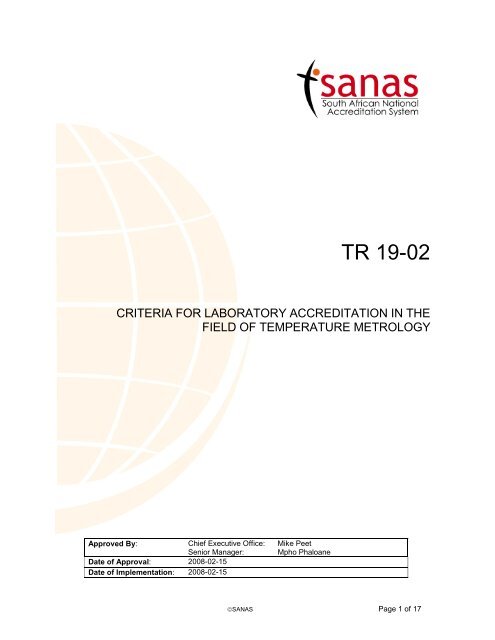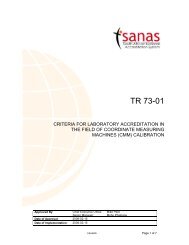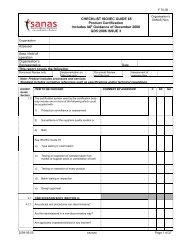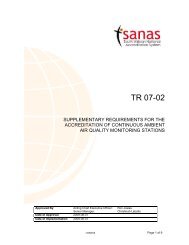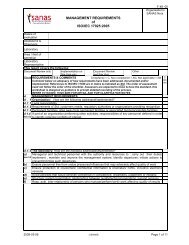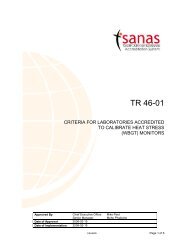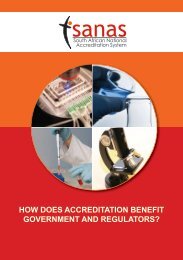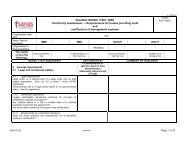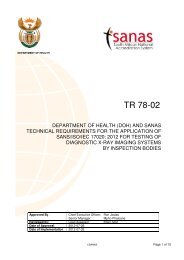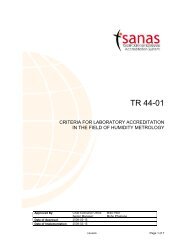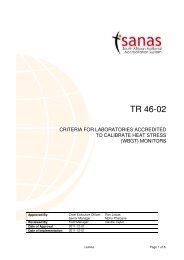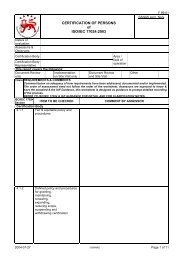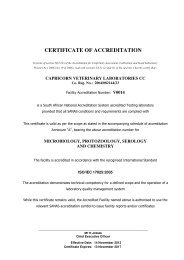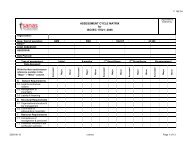TR 19-02 - Sanas
TR 19-02 - Sanas
TR 19-02 - Sanas
You also want an ePaper? Increase the reach of your titles
YUMPU automatically turns print PDFs into web optimized ePapers that Google loves.
<strong>TR</strong> <strong>19</strong>-<strong>02</strong>CRITERIA FOR LABORATORY ACCREDITATION IN THEFIELD OF TEMPERATURE ME<strong>TR</strong>OLOGYApproved By: Chief Executive Office: Mike PeetSenior Manager: Mpho PhaloaneDate of Approval: 2008-<strong>02</strong>-15Date of Implementation: 2008-<strong>02</strong>-15©SANAS Page 1 of 17
<strong>TR</strong> <strong>19</strong>-<strong>02</strong>CONTENTS:1. Purpose and Scope2. References3. Definitions and Abbreviations4. Environmental Requirements5. General Requirements6. Technical Requirements7. Authorship8. The Accreditation ScheduleAppendix 1.Appendix 2.Example of Accreditation SchedulAdditional DefinitionsADDENDUM 1.Amendment Record©SANAS Page 2 of 17
<strong>TR</strong> <strong>19</strong>-<strong>02</strong>1. Purpose and ScopeThe purpose of this document is to define the specific environmental, general and technicalrequirements to be met by accredited laboratories in the field of temperature measurement andcalibration and includes those DCLF electrical laboratories accredited to perform electrical simulation oftemperature instrumentation. This document is applicable to South African National AccreditationSystem (SANAS) Accredited Laboratories in these fields.2. References[1] OHS Act, <strong>19</strong>93 Environmental Regulations <strong>19</strong>87 - Lighting[2] OHS Act, <strong>19</strong>93 General Admin Regulations <strong>19</strong>94 – Handling of HazardousChemical Substances[3] SANS ISO/IEC 17<strong>02</strong>5:2005 General requirements for the competence of testing andcalibration laboratories[4] ASTM E 344-00 Terminology relating to Thermometry and Hygrometry.[5] EA-10/11 EA Guidelines on the Calibration of Temperature Indicatorsand Simulators by Electrical Simulation and Measurement.[6] IEC-584-1 International Electrotechnical CommissionThermocouples – Part 1 Reference Tables[7] IEC-584-2 International Electrotechnical CommissionThermocouples – Part 2 Tolerances[8] EA 10/08 Ed 1 European co-operation for AccreditationCalibration of Thermocouples Edition 1 Oct <strong>19</strong>97(EAL-G31)[9] EA 10/13 European co-operation for AccreditationEA Guidelines on the calibration of Temperature BlockCalibrators, Nov <strong>19</strong>99.[10] OIML R133 International Organization of Legal MetrologyLiquid-in-glass thermometers, Ed. 20<strong>02</strong>(E)[11] AS TG 3 IANZ Technical Guide Working ThermometersCalibration Procedures, March 20<strong>02</strong>.[12] WIKA – Handbook Pressure and Temperature Measurement, <strong>19</strong>95[13] VIM <strong>19</strong>93 International Vocabulary of Basic and General Terms inMetrology, 2 nd Edition, <strong>19</strong>93, Issued by BIPM, IEC, ISO, andOIML.[14] SANAS <strong>TR</strong> 46 Criteria for Laboratories Accredited for the calibration of HeatStress (WBGT) Monitors[15] NPL Guide 4 Introductory Guide to emissivity, NPLhttp://www.npl.co.uk/thermal/stuff/guide4.html3. Definitions and Abbreviations3.1 DefinitionsAnnealingAnnealing or heat treatment is the process whereby a thermocouple or resistance thermometeris relieved of internal stresses by heating at a fixed temperature for a specified time period.BlackbodyA blackbody is an entity that absorbs all electromagnetic radiation falling upon it. As a perfectabsorber, it neither reflects nor transmits, and has an emissivity of 1. [15]Compensating TC CableCompensating cable is made of different alloys to that of the thermocouple, but manufactured tomatch the emf/temperature characteristic of the thermocouple, but over a restricted temperaturerange. [8]Contact Thermometer©SANAS Page 3 of 17
<strong>TR</strong> <strong>19</strong>-<strong>02</strong>An instrument that is adapted for measuring temperature by means of thermal conductivity bydetermining the temperature at the moment when negligible thermal energy flows between thethermometer and the object of measurement. [4]Electrical SimulationIn this application, simulation is the process of replacing a temperature sensor (thermocouple orresistance thermometer) by an equivalent electrical device in order to calibrate a temperatureindicator or transducer. [5] Electrical simulation may also include the calibration of temperatureindicator using a current or voltage input such as 4-20mA, or 1-5 volts.International System of Units, SIThe coherent system of units adopted and recommended by the General Conference onWeights and Measures (CGPM) based on seven base units, namely metre (m), kilogram (kg),second (s), ampere (A), kelvin (K), mole (mol) and candela (cd). [13]Thermocouple.A thermocouple is a pair of conductors of dissimilar materials joined at one end forming part ofan arrangement using the Seebeck thermoelectric effect for temperature measurement. [7]Kelvin, KBase unit of the temperature in the International System of Units (SI). [4]Liquid-in-glass ThermometerA temperature measuring instrument whose indications are based on the temperaturecoefficient of expansion of a liquid relative to that of its containing glass bulb. [4]Measuring JunctionThat junction of a thermocouple which is subjected to the temperature to be measured [4]sometimes referred to as the hot junction.Radiation ThermometerA radiometer calibrated to indicate the temperature of a blackbody. [4] This thermometer is anon-contact type.Ice PointA secondary fixed point, 0.0 °C, on the Internation al Temperature Scale of <strong>19</strong>90 (ITS-90), that isa melting mixture of pure ice and water that realizes the temperature of 0.0 °C. Distilled watermust be used as well as ice made with distilled water to realise the ice point.Reference JunctionThat junction of a thermocouple which is at a known temperature. [4]Cold Junction CompensationInternal cold junction compensation is applied in thermocouple measuring instruments. Itdetermines the temperature at the input junctions of the instrument and applies a microvoltcorrection for the deviation of the temperature from 0 °C for the specific type of thermocouplemeasured.Response TimeTime interval between when a stimulus is subjected to a specified abrupt change and the instantwhen the response reaches and remains within specified limits around its final steady value.The response time for a sensor is the time taken to achieve 99.5% of the step change and isequal to approximately 5 time constants. (See time constant).Spectral EmissivitySpectral emissivity is a dimensionless number lying between 0 and 1, and is defined as the ratioof energy radiated from a surface to that of a blackbody at the same temperature, at the samewavelength and under the same viewing conditions. [15]Temperature Block CalibratorTemperature block calibrators comprise a solid block, with a temperature controller andindicator. The block has borings intended for the calibration of thermometers. [9]©SANAS Page 4 of 17
<strong>TR</strong> <strong>19</strong>-<strong>02</strong>Temperature MappingTemperature mapping is the evaluation of the temperature uniformity and stability in theapplicable volume by the use of several temperature probes.Time ConstantThe Time Constant, Τ, of a sensor is defined as the time taken for it to achieve 63.2% of a stepchange in temperature.RepeatabilityThe ability of a measuring instrument to provide closely similar indications for repeatedapplications of the same measurands under the same conditions of measurement. [13]Zone of HomogeneityWith reference to Temperature Block Calibrators the ‘zone of homogeneity’ is that zone of atleast 40mm in length, normally located at the lower end of the boring into which thethermometer to be calibrated is inserted. [9]3.2 AbbreviationsCJCDCLFELCKLIGmAMSDSPt 100UoMUU<strong>TR</strong>JRTDSANASSITCWBGTCold Junction CompensationDirect Current Low FrequencyEmergent Liquid ColumnKelvinLiquid-in-GlassMilliampMaterial Safety Data SheetsPlatinum Resistance Thermometer with R(0°C) = 100ΩUncertainty of MeasurementUnit under TestReference (cold) JunctionResistance Temperature DeviceSouth African National Accreditation SystemInternational System of UnitsThermocoupleWet Bulb Globe Temperature4. Environmental RequirementsAn accredited laboratory working in the field of temperature measurements shall operate under thefollowing environmental conditions:4.1 The laboratory shall be maintained at a temperature of 23 ° C ± 5 ° C. Where measurements areperformed outside this specified limit, the laboratory must produce documented evidence thatthe results have been validated, for example when measurements are performed on-site.4.2 Rates of change and gradients of the ambient temperature must be kept to below 2 ºC per hour.4.3 A high degree of cleanliness shall be maintained in the laboratory and adequate lighting shall beprovided. [1]5. General Requirements5.1 Laboratories may be accredited for the calibration of:• noble and base metal thermocouples;• TC compensation and extension leads;• surface temperature probes;• ice point reference;• triple point of water;• platinum resistance thermometers;©SANAS Page 5 of 17
<strong>TR</strong> <strong>19</strong>-<strong>02</strong>• thermometers including liquid-in-glass, digital, and mechanical (bi-metal or filledsystems);• electrical simulation calibration of both TC and RTD temperature indicators,controllers, transmitters and temperature calibrators, including the calibration of CJC;• radiation thermometers;• tungsten ribbon lamps;• Isothermal media evaluation, including autoclaves, sterilizers, and environmentalchambers;• temperature installations, including ovens, incubators, stirred water baths, fridges, andfreezers;• heat stress monitors;• temperature recorders including thermo-hygrographs, and data loggers;• surface temperature of hot plates;• dry block temperature calibrators,• on site accreditation for any of the above, but excluding triple point of water.(Refer to the Schedule of Accreditation – Temperature Metrology Appendix 1)5.2 The laboratory shall measure the output of the UUT in the units applicable. Generally, the unitswill be °C, with certain exceptions such as thermocoup les, the output being measured in µVoltsor millivolts, resistance thermometers, the output being measured in ohms, temperaturetransducers the output in mA. In the case of temperature calibrators, the units may be °C, orthe applicable electrical units.5.3 Laboratories shall report the results accurately, clearly, unambiguously and objectively. [3] It istherefore preferable to report measurement results where applicable in both the electrical unit(mV, µV, mA or Ω) and the equivalent temperature in °C. Where resu lts are reported in non-SIunits, the equivalent SI unit shall be reported alongside and the applicable conversion factorshall be stated.5.4 The laboratory is required to have MSDS for all standards fluids, and chemicals andhazardous cleaning materials used within the laboratory, for example, but not limited to acids,organic solvents, salts, temperature bath fluids, etc. [2]5.5 If the laboratory either uses or calibrates Liquid-in-Glass thermometers they shall have anMSDS for Mercury, and a procedure describing how mercury spills are to be cleaned up. [2]5.6 The laboratory is required to have procedures in place for the storage and usage ofstandards in order to ensure their ongoing integrity.5.7 The laboratory shall have and apply procedures for all calibrations, including the making up ofan ice point reference.5.8 The laboratory shall be equipped with suitable isothermal heat sources such as stirred liquidbaths, furnaces, and/or block calibrators for the calibration of temperature sensors.5.9 Where digital multimeters are used to measure the output of thermocouples, transmitters, andRTD’s, the specification of the digital multimeter shall be used in the estimation of the UoM,unless it can be shown that sufficient measurements over the applicable measurement range(mV, mA, Ω) have been made by the calibrating laboratory, allowing for interpolation andcorrection where applicable, and subsequently the use of the UoM specified by the calibratinglaboratory.6. Technical Requirements6.1 Thermocouple Calibration6.1.1 The laboratory should have the appropriate reference junctions for each type ofthermocouple as required, both base metal and noble metal, and shall use these asappropriate for the calibration of thermocouples.©SANAS Page 6 of 17
<strong>TR</strong> <strong>19</strong>-<strong>02</strong>6.1.2 TC reference junctions should be calibrated, and a calibration certificate issued for eachRJ. The uncertainty of the RJ shall be taken in to account in the uncertainty budget forany calibration where the RJ has been used.6.1.3 In instances where the reference junctions have not been calibrated then the laboratoryshall use the manufacturer’s specification for the extension or compensating wire as thebasis for the uncertainty of the reference junction.6.1.4 The laboratories procedure for the calibration of thermocouples shall address as aminimum:• depth of immersion;• temperature variation of the thermal source;• time and spatial temperature distribution of the thermal source;• annealing;• temperature variation of the cold (reference) junction;• parasitic thermovoltages;• electromagnetic interference;• Initial inspection (obvious defects, contamination, etc.)• calibration of digital voltmeters or direct reading temperature indicators.[8]6.1.5 The calibration procedure shall address possible calibration changes of type Kthermocouples (and to a lesser extent other base metal thermocouples) when exposedto temperature cycling at 500ºC or above. [8]6.2 Compensation and Extension TC Calibration6.2.1 The calibration of compensation or extension thermocouple cable will take place over alimited range, typically not exceeding 0ºC to 70ºC.6.2.2 When a sample of TC cable or TC compensating or extension cable is calibrated andtaken to be representative of a reel or length of cable, the laboratory shall address therequirements for sampling as specified in Clause 5.7 of ISO/IEC 17<strong>02</strong>5:20056.2.3 Procedures for the calibration of compensation and extension thermocouple wire shalladdress those aspects identified in 6.1.4 above.6.3 Surface Temperature Probes6.3.1 The laboratory shall have procedures that describe how the thermocouple measuring tipis to make contact with the measuring (hot) surface, and the applicable settling time,necessary to produce repeatable measurements.6.3.2 The laboratory shall have a suitable measurement source such as a hotplate, with asuitable surface finish together with a reference surface temperature thermometer.6.4 Ice Point Reference6.4.1 The procedure for the preparation of the ice point reference, shall include the method ofpreparation, the type and grade of water to be used, appearance, and expecteduncertainty.6.4.2 An Ice point prepared with reasonable care should reproduce 0ºC ± 0,05ºC or better.[11]6.5 Resistance Thermometer Calibration6.5.1 The laboratories procedure for the calibration of resistance thermometers shall addressas a minimum:• depth of immersion;• temperature variation of the thermal source;• time and spatial temperature distribution of the thermal source;• annealing;• connection configuration and colour coding;©SANAS Page 7 of 17
<strong>TR</strong> <strong>19</strong>-<strong>02</strong>• self heating;• Initial inspection (obvious defects, contamination, etc.)• calibration of digital multimeters or direct reading temperature indicators;• possible loading effects when using a digital multimeter.6.5.2 The annealing of a resistance thermometer shall only take place with the consent of thecustomer, and shall be recorded as part of the contract review process.6.5.3 Where no other requirement has been specified by the customer the thermometershould be allowed to cool by:• For thermometers used only up to approximately 450°C, they may be removedfrom the heat source and allowed to cool down to ambient conditions;• For thermometers used above that temperature, after annealing the thermometershould be allowed to cool down to 450 ° in the heat s ource, where-after it may beremoved and allowed to cool down to ambient.6.6 Liquid in Glass Thermometer Calibration6.6.1 The procedure/s for calibration of LIG thermometers shall describe complete, partialor/and total-immersion of the thermometer, and shall include the method for thecalculation of emergent liquid column corrections where appropriate.6.6.2 Certificates issued for the calibration of LIG thermometers shall include all relevantinformation on the thermometer including details of the manufacturer, serial number,measuring range, type, scale interval, immersion type and depth, in addition to themeasurement results.6.6.3 The calibration procedure shall include a visual inspection of the thermometer for grossdefects such as missing graduations, broken column, and separations in thethermometric liquid. [11]6.6.4 The calibration procedure shall include the method for handling, storage andtransportation of LIG thermometers.6.6.5 A magnifying eyepiece and suitable light source should be used to reduce parallaxerrors and increase readability. [11]6.6.6 It must be noted that block calibrators, may not be suitable for the calibration of totalimmersion liquid-in-glass thermometers, since, in most cases, these cannot beimmersed to the appropriate depth required over the full temperature range.6.7 Digital Thermometer Calibration6.7.1 The calibration of a digital thermometer may include electrical simulation. This isaddressed separately in section 6.9 of this document.6.7.2 The laboratories procedure for the calibration of digital thermometers shall address as aminimum:• depth of immersion;• temperature variation of the thermal source;• time and spatial temperature distribution of the thermal source;• temperature variation of the cold (reference) junction;• electromagnetic interference;• Initial inspection (obvious defects, contamination, etc.).6.7.3 Typically hand held digital thermometers use either TC type K, RTD Pt 100, orthermistor temperature sensors. Subsequently range, stability and accuracy will differbetween all of these types, and cognisance of these differences shall be consideredwhen the UoM is estimated.6.7.4 When a digital thermometer is calibrated with a temperature probe, both thethermometer and probe shall be uniquely identified. If the probe is detachable, or©SANAS Page 8 of 17
<strong>TR</strong> <strong>19</strong>-<strong>02</strong>interchangeable the certificate shall include a disclaimer that the calibration is only validwhen the digital thermometer is used with the specified temperature probe.6.7.5 Digital thermometers that include an externally accessible ‘zero’ adjustment, shall havethe adjustment screw sealed with a tamper proof sticker, after the calibration has beencompleted.6.8 Mechanical Dial Thermometer Calibration6.8.1 Mechanical dial thermometers can be separated into two distinctive types, thoseoperating with a filled liquid capillary system, and those incorporating a bi-metallic strip,or bi-metallic helical coil.6.8.2 Mechanical dial thermometers are generally less accurate than other types ofthermometer and are typically used in industrial applications, rather than in a laboratoryenvironment.6.8.3 Mechanical effects due to friction in the transmission and indication may result in adifference in rising and falling temperatures (hysteresis) and this shall be consideredduring the estimation of the UoM. [12]6.8.4 The procedure shall address the immersion depth.6.8.5 In instances where the thermometer is provided with an external means of adjustmentto offset changes in the calibration, such as an adjustable dial, or pointer, thisadjustment shall be sealed with a tamper proof sticker after the calibration has beencompleted. .6.8.6 Mechanical dial thermometers manufactured to the German DIN 16203, standard willinclude two ranges, the indication range (as marked on the dial), and the measuringrange (indicated on the dial by two triangles). The thermometer is not intended to beused outside of the measuring range. [12]6.9 Electrical Simulation6.9.1 The laboratory shall have and apply procedures for the calibration of temperatureindicators and controllers by electrical simulation. Temperature indicators andcontrollers are instruments that convert an electrical signal to a reading in temperatureunits. Temperature simulators and calibrators are also typically capable of producingan electrical signal equivalent to the output setting in temperature units on the device.6.9.2 Procedures shall address the interconnections for calibration purposes of the standardand the UUT. For RTD devices this shall include 2, 3 or 4 wire connections. For TCdevices the procedure shall address the use of compensating leads, including theirpolarity, and the use of reference junctions.6.9.3 The laboratory shall have copies of all reference tables for all thermocouple types, andresistance thermometers that they are accredited to calibrate. [5] The laboratory shouldalso have TC colour charts available.6.9.4 The temperature scale used to express temperature values in the calibration certificateshall be clearly stated. Unless requested by the customer the InternationalTemperature Scale of <strong>19</strong>90 (ITS-90) shall be used. [5]6.9.5 The standard reference tables used to convert the electrical signals to temperaturevalues together with their reference/identification numbers shall be stated on thecalibration certificate. [5]6.9.6 For calibrators or simulators capable of measuring and simulating several different typeof temperature sensor, the calibration certificate shall clearly indicate the sensor types,and range covered by the calibration, and this should have been agreed with thecustomer.[5]©SANAS Page 9 of 17
<strong>TR</strong> <strong>19</strong>-<strong>02</strong>6.9.7 Certain temperature calibrators or simulators have a selectable CJC feature, allowingthe CJC to be enabled or disabled, or manually set to a temperature such as 0ºC orambient. These instruments may be calibrated using either method. The calibrationcertificate shall clearly indicate if the results were obtained with the CJC enabled,disabled or manually set. [5]6.10 CJC Calibration6.10.1 The laboratory shall have procedures for the calibration of the CJC when this isperformed separately to the TC output or input function of the UUT.6.10.2 The procedure shall take cognisance of the fact that the CJC temperature is measured,usually with a sensor bonded to one of the terminals, and therefore the temperaturestability of the UUT is as critical as the stability of an Ice point that may be used as partof the calibration.6.11 Radiation Thermometer Calibration6.1.1 The laboratory procedures for the calibration of Radiation Thermometers shall address:• Spectral emissivity,• Alignment with the target,• Size of the source.6.12 Isothermal Evaluation - Autoclaves6.12.1 The calibration / performance evaluation of a sterilising autoclave shall be conducted inaccordance with the requirements as agreed during the contract review.6.12.2 The requirements for the calibration / evaluation of an Autoclave may be superseded byregulatory requirements.6.12.3 It is recommended that a multipoint calibration / evaluation be performed.6.12.4 Care must be taken to ensure that the pressure seal of the lid of the autoclave is notdamaged, should it be necessary for temperature sensor wires be fed into the chambervia the lid. Individual temperature loggers can be used instead of conventionaltemperature sensors (TCs or RTDs) to overcome the problem of gaining access to thechamber.6.12.5 Since the evaluation of autoclaves is done over elapsed time, the laboratory shall haveand maintain a suitable time standard to calibrate the timer of the autoclave. Similarly,a calibrated pressure gauge with manifold and pressure pump can be used for thecalibration of the pressure gauge of the autoclave.6.12.6 A temperature laboratory may apply for limited Time Interval and Pressure accreditationfor the calibration of autoclaves only. This accreditation may not be used for any otherpurpose.6.12.7 The certificate / report shall include a disclaimer that the calibration / evaluation doesnot cover the inspection of the autoclave as a pressure vessel that may be required interms of legislation.6.13 Isothermal Evaluation - Sterilizers6.13.1 The evaluation of non-pressurized sterilizers is achieved by temperature mappingalone.6.14 Environmental Chamber Evaluation6.14.1 The calibration of environmental chambers necessitates the following measurements:• Variations in space for temperature and % relative humidity• Variations in time for temperature and % relative humidity©SANAS Page 10 of 17
<strong>TR</strong> <strong>19</strong>-<strong>02</strong>6.14.2 It is recommended that the humidity is measured at the same point in the chamberwhere the temperature is measured. Applying humidity calculations to humiditymeasured in the centre of the chamber, based on the spatial temperaturemeasurements, may provide incorrect humidity spatial values.6.15 Temperature Installations6.15.1 Laboratories performing the calibration of temperature indicators, controllers andrecorders excluding the temperature probes shall be accredited for electrical simulation.6.15.2 The calibration may include temperature mapping for large volumes.6.16 Heat Stress Monitor Calibration6.16.1 The requirements for the calibration of Heat Stress Monitors, otherwise known asWBGT monitors is addressed in SANAS document R46 ‘Calibration of Heat StressMonitors’.6.17 Temperature Recorder Calibration6.17.1 Laboratories performing the calibration of temperature recorders such as thermohygrographsor data loggers shall be equipped with a suitable chamber.6.18 Hotplate Calibration6.18.1 The laboratory shall have suitable reference surface temperature thermometers in orderto perform these calibrations.6.18.2 The laboratory shall have procedures that describe how the thermocouple measuring tipis to make contact with the measuring surface of the hotplate, and the applicable settlingtime, necessary to produce repeatable measurements.6.<strong>19</strong> Temperature Block Calibrator Calibration6.<strong>19</strong>.1 The calibration of a Temperature Block Calibrator includes an evaluation ofperformance of the calibrator.6.<strong>19</strong>.2 The calibration procedure shall therefore cover the following measurements as aminimum:• An evaluation of the zone of homogeneity, in the central boring or a specificallyidentified marked boring;• The greatest temperature difference between the borings at a specifiedtemperature;• Stability over a 30 minute period, after stability has been reached;• Calibration against the indicated temperature at a minimum of 3 differenttemperatures, distributed uniformly over the temperature range excludingambient. If one of the desired temperatures is near ambient the temperature shallbe increased or decreased by approximately 20ºC from ambient. [9]6.<strong>19</strong>.3 Where any of the above measurements have not been performed this shall be specifiedon the calibration certificate.6.<strong>19</strong>.4 In addition the calibration procedure shall address:• The outside diameter of the thermometer used to perform the calibration relativeto the inside diameter of the boring or bushing;• The minimum immersion length;• The use of insulation materials on the top of the block;• The location of the thermometer in the zone of homogeneity during calibration;• Heat conduction when using a standard thermometer with a diameter ≥ 6mm. [9]©SANAS Page 11 of 17
<strong>TR</strong> <strong>19</strong>-<strong>02</strong>6.20 On-Site Calibration7. Authorship6.20.1 Laboratories wishing to be accredited for on-site work shall have procedures thatdescribe how equipment including standards are to be transported, how measurementstandards are validated (intermediate checks performed) to ensure the on-goingintegrity and accuracy of the measurement standards.This Technical Requirement document has been prepared by a working group committee consistingthe following members:of• Neville Tayler SANAS• Steve Sidney NLA• Neville Robinson Private• Mark Mathieson Unique Metrology• Hans Liedberg NML CSIR• Yvette Volschenk Apollo Scientific• Guy Snelling Intercal• Bart van Oostrom PrivateSANAS is indebted to the contribution made in the preparation of this document.8. The Accreditation ScheduleThe accreditation schedule shall follow the following format; the functions will be determined by thelaboratory application. Ranges and uncertainties are illustrative.See Appendix 1©SANAS Page 12 of 17
<strong>TR</strong> <strong>19</strong>-<strong>02</strong>Appendix 1S C H E D U L E O F A C C R E D I T A T I O NTEMPERATURE ME<strong>TR</strong>OLOGYLaboratory Accreditation Number 3XXPermanent Address of Laboratory:SuperLab25 Popular StreetTree ParkPort Southern AfricaPostal Address:P O Box 22222Port Southern AfricaX000Tel : (055) 321-4567Fax : (055) 321-6789E-mail: dolittle@mweb.co.zaTechnical SignatoriesNominated RepresentativeIssue No.Date of issueExpiry date: Dr I. DolittleMr D Green: Mrs M Brown: 01: October 200X: October 200XITEM FUNCTION NOMINAL RANGEMEASUREMENT CAPABILITYEXPRESSED AS ANUNCERTAINTY (±)1 Thermocouples: Noble MetalBase MetalCompensation and Extension LeadSurface Temperature Probes0 ºC to 70ºC70ºC to 650 ºC650 ºC to 1820 ºC-50 ºC to 0ºC0ºC to 70ºC70ºC to 150 ºC150 ºC to 650 ºC650 °C to 1370 °C0 ºC to 70 ºC50 ºC to 150 ºC150 ºC to 350 ºC0,3 K2,0 K4,0 K1,0 K0,2 K1,0K2,5 K4,0 K0,3 K1,5 K5,0 K2 Ice Point Reference 0,0 ºC 0,1 K3 Water Triple Point Cell 0,01 °C 0,001 K4 Platinum Resistance Thermometers -60 ºC to 180 ºC180 ºC to 650 ºC650 °C to 850 °C0,3 K0,6 K1,5 K5 Thermometers Liquid–in-glassDigital ThermometersMechanical (Dial) Thermometers-20 ºC to 50 ºC50 ºC to 180 ºC180 ºC to 450 ºC-40 ºC to 200 ºC200 ºC to 800 ºC-50 ºC to 50 ºC50 ºC to 200 ºC200 ºC to 500 ºC0,2 K0,6 K1,5 K0,2 K0,6 K1,5 K2,5 K5,0 KPage 1 of 2Laboratory Accreditation Number : 3XXDate of Issue : October 200X©SANAS Page 13 of 17
<strong>TR</strong> <strong>19</strong>-<strong>02</strong>Expiry Date : October 200XITEM FUNCTION NOMINAL RANGEMEASUREMENTCAPABILITIES EXPRESSEDAS AN UNCERTAINTY (±)6 Electrical SimulationIndicators-50 ºC to 300 ºC300 ºC to 1200 ºC0,3 K1,5 KTransmitters-50 ºC to 300 ºC300 ºC to 1200 ºC0,5 K2,0 KCalibrators-50 ºC to 550 ºC550 ºC to 1350 ºC1350 °C to 1800°C0,2 K0,5 K4,0 KCold Junction Compensation0º to 30ºC0,5 K7 Radiation Thermometers 0 ºC to 200 ºC200 ºC to 1600 ºC2,0 K5,0 K8 Tungsten Ribbon Lamps 800 ºC to 2 200 ºC 0,6% of Reading9 Isothermal Media EvaluationAutoclaves - Temperature- Pressure- TimeSterilizersEnvironmental Chambers/Drying Ovens20 °C to 140 °C0 to 140 kPa0 to 120 minutes20 °C to 300 °C20 °C to 140 °C0,5 K2 kPa10 sec2,0 K0,5 K10 Temperature InstallationsFurnaces, Ovens, Incubators, StirredWater baths, Fridges and Freezers, etc-40 ºC to 150 ºC150 ºC to 650 ºC0,5 K2,0 K11 Heat Stress Monitors(WBGT Monitors)0 °C to 50°C 0,5 K12 Temperature RecorderThermo-HygrographData Loggers0 °C to 60 °C0 °C to 60 °C1,0 °C0,5 ° C13 Hot Plates(Surface Temperature)50 °C to 300 °C 5,0 K14 Dry Block Temperature Calibrators -50 ºC to 1 200 ºC 0,3 K15 On-site for items X, Y and z aboveOriginal date of accreditation: 20<strong>02</strong> Page 2 of 2Appendix 2©SANAS Page 14 of 17
<strong>TR</strong> <strong>19</strong>-<strong>02</strong>Additional Definitions• Base Metal ThermocoupleThermocouple whose thermo-elements are composed primarily of base metals and their alloys. [4]• BlackbodyThe perfect or ideal source of thermal radiant power having a spectral distribution described by thePlanck equation. The term blackbody is often used to describe a furnace or other source of radiantpower which approximates the ideal. [4]A reference source of infrared radiation made in the shape of a cavity and characterised byprecisely known temperature of the cavity walls and having effective emissitivity at the cavityopening arbitrarily considered equal to unity.• Compensating Extension WiresThose extension wires fabricated from materials basically different in composition from thethermocouple. They have similar thermoelectric properties and within a stated temperature rangeeffectively transfer the reference junction to the other end of the wires. [4]• Complete Immersion ThermometerA liquid-in-glass thermometer designed to indicate temperatures correctly when the entirethermometer is exposed to the temperature being measured.[4]• Degree Celsius, ºCDerived unit of temperature in the International System of Units (SI). (See Kelvin).At any temperature, an interval of one degree Celsius is the same as an interval of one Kelvin, bydefinition.[4]• Extension WiresThose having temperature emf characteristics that when connected to a thermocouple effectivelytransfers the reference junction to the other end of the wires. [4]• International Practical Temperature Scale of <strong>19</strong>68 (IPTS-68)The temperature scale adopted by the 13 th General Conference on weights and Measures in <strong>19</strong>68. TheIPTS-68 was superseded by the International Temperature Scale of <strong>19</strong>90. [4]• International Temperature Scale of <strong>19</strong>90 (ITS-90)The temperature scale prepared in accordance with instructions of the 18 th General Conference onWeights and Measures, and adopted on January 1, <strong>19</strong>90.• Noble Metal ThermocoupleThermocouple whose thermo elements are composed of primarily of noble metals and theiralloys. [4]• Partial Immersion ThermometerA liquid in glass thermometer designed to indicate temperature correctly when the bulb and aspecified part of the stem are exposed to temperatures being measured. [4]• RadiometerA device for measuring radiant power that has an output proportional to the intensity of the input power.[4]• Resistance ThermometerA temperature measuring device comprised of a resistance thermometer element, internalconnecting wires, a protective shell with or without means for mounting, a connection head, aconnecting wire, or other fittings, or both. [4]• Self-heatingThe increase in the temperature of the thermometer element caused by the electric powerdissipated in the element, the magnitude depending upon the thermometer current and heatconduction from the thermometer element to the surrounding medium. [4]©SANAS Page 15 of 17
<strong>TR</strong> <strong>19</strong>-<strong>02</strong>• ThermistorA semiconductor, the primary function of which is to exhibit a monotonic decrease in electricalresistance with an increase in sensor temperature, that is, a semiconductor for which the temperaturecoefficient of resistance is negative and exhibits neither discontinuities nor changes in sign. [4]• Total Immersion ThermometerA liquid in glass thermometer designed to indicate temperature correctly when just that portion of thethermometer containing the liquid is exposed to temperatures being measured.[4]• Triple Point of WaterTriple point of the liquid, solid, and vapour phases of water. [4]©SANAS Page 16 of 17
<strong>TR</strong> <strong>19</strong>-<strong>02</strong>ADDENDUM 1.AMENDMENT RECORDProposed By: Section ChangeCEO Page 1 Changed to new logo & Front pageQM Section 2 Changed reference to R 46 to <strong>TR</strong> 46©SANAS Page 17 of 17


